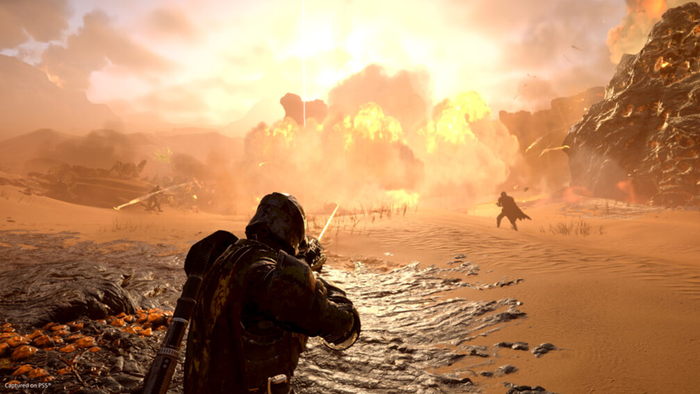
Featured Blog | This community-written post highlights the best of what the game industry has to offer. Read more like it on the Game Developer Blogs.
Structure or AI Director?
We might be getting overly obsessed with Left 4 Dead's AI Director.

I'd like to take a moment to address a recurring theme I'm finding in comment threads. I've been talking a lot about video game structure and progression, and many, many times now I've seen people refer to Left 4 Dead's AI Director mechanic as an ideal way of managing player interaction and drama in real time.
There are a number of things that rub me the wrong way about this. But the irony of this is that the AI Director, a method of real-time adjustment to player performance, came from a developer with a very firm understanding of built-in gameplay structure... Valve.
I mean, let's just run through The Orange Box real quick:
Half-Life 2 (and Episodes One and Two)

Half-Life 2's oppressive domestic battleground.
How much needs to be said about Half-Life 2 that hasn't already been said? The Half-Life 2 experience has a sublime intensity the likes of which is seen in very few games. It does so much to directly affect the player in dramatic ways - from ordering them to pick up a can to bombing the river they're boating through to making them watch as a gigantic hyper-friendly robot prepares to throw an entire dumpster at them in a determined effort to play "catch." Even gunning down Combine in City 17 is dramatic, if only because you're constantly on the run.
It's a shining example of how structured, dramatic level design can make gameplay that much more compelling and immersive.
Portal

Or rather, how it does not affect momentum.
And Portal takes things one step further. Portal is the kind of game where every single aesthetic choice is meant to affect player behavior and help them grasp the concepts required for Portal puzzle-solving.
An aunt of mine once said to me, "Whatever you do, don't design a game like Portal." Naturally, this shocked me, and I had to inquire further. Turns out her husband was just as obsessed with the game as I was, so she had played it once out of curiosity. She was unsuccessful; she couldn't get her head around the complex puzzles. This bothered me for a while, before I asked, "Did you start at the beginning?" She replied that she'd simply jumped into a level in the middle of the game.
Well, there you go. Each and every level is a player training exercise, where the shape, color, texture, structure, pacing, and everything else is subtly teaching the player important concepts and making them more likely to succeed in the game's intense climax. And it's more than happy to let the player believe that they did it all by themselves. Well, except GLaDOS: "I just want you to know that you were given every opportunity to succeed."
Team Fortress 2

A well-placed turret.
Team Fortress 2 is perhaps the most impressive example of them all. How in the world do you structure open-ended multiplayer behavior? How do you give competitive multiplayer any sort of dramatic structure with highs and lows?
As Valve demonstrates, through veeeeeery precise level design.
Individual class abilities provide peaks and pacing in the action, but the design work that goes into each map makes the most of those traits. Each level is precisely tuned to factor in any number of player behaviors:
What alternate routes does the Scout have access to? What spaces does the Soldier have to rocket jump and shoot down from? What corners can Pyros and Heavies ambush around? Where can the Demoman plant mines without them being easily removed? Where are the ideal placements for the Engineer's teleporters, dispensers, and turrets? Where is the Medic most likely to deploy the Übercharge? What paths can the Spy use to sneak around the enemy line? And, of course, what vantage points are available to the Sniper?
And these are piled on top of the normal considerations for deathmatch level design: balance, choke points, multiple routes, distance of spawn points to where the action is...
All these questions are factored into the level design of every map! It's crazy! And through this, Valve has managed to account for, manipulate, and make the most of all potential open-ended player behaviors. It's a modern achievement.
Left 4 Dead

It's them versus the AI Director.
So let's get back to Left 4 Dead. There's certainly plenty of dramatic structure built into the levels in Left 4 Dead's campaigns, between the choke points and the places where you have to defend yourself while you wait for an elevator or something. The AI Director is by no means the only source of dramatic player/game interaction. If anything, it's more of a... fine-tuning element than the core of the gameplay.
The nature of the game demands an AI Director, though. You can't have consistent places for enemy and item spawns because the levels are short and replayable. And when four players put their heads together, you need a game behavior that's just as smart.
In the end, we don't require an AI Director element to get the most out of player involvement. That's the level designer's job - to create areas of gameplay that, through their shape, size, color, texture, and everything else, organically create the rhythms and dramatic structures that make engaging gameplay.
Don't get me wrong; the AI Director is ingenious. But there's a lot more to our craft than just that.
Read more about:
Featured BlogsAbout the Author(s)
You May Also Like













